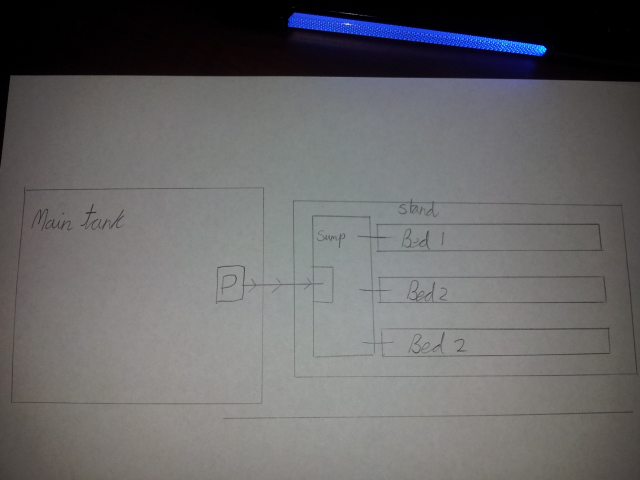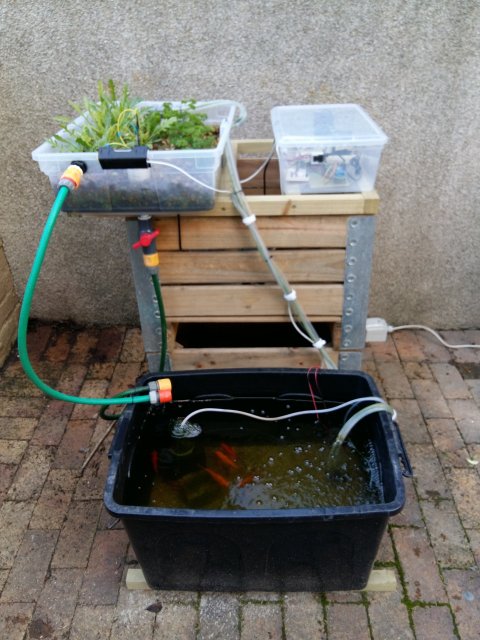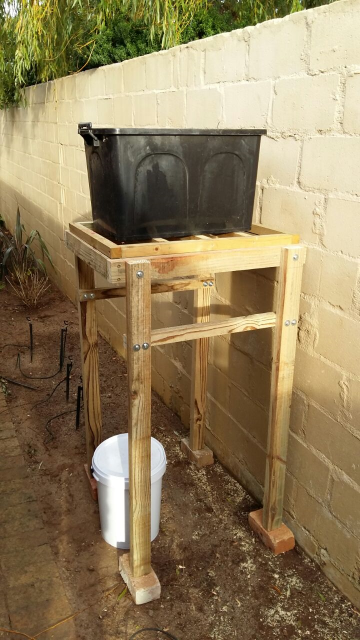So for my science project and to satisfy my need to do more aquaponics (hopeful career  )i am building a large aquaponic system to test how root exposure to water affects plant growth, This is all i have done for my report so far:
)i am building a large aquaponic system to test how root exposure to water affects plant growth, This is all i have done for my report so far:
To test my subject i will be using an 1000 litre container, filled to 600-800 litre containing goldfish (amount undecided) to produce nutrients for the plants in the form of Nitrate (N03) produced through the nitrogen cycle in ‘beneficial’ aerobic bacteria living in biological media in the filter by digesting: amino acids, dissolved organic substances, urea, solid wastes (after mineralising) and other decomposing substance in the water. Macro nutrients (magnesium, sodium etc) are provided from fish waste, fish food and if necessary liquid nutrient supplements.
The test will be conducted to find the most effective form of aquaponic planting; deep water culture, nutrient film or timed media beds because each method is said to be better than the other for various reasons.
Nutrient film is a popular Hydroponic method that uses a long tube with planted pots with a very small layer of water at the bottom allowing plant roots to be exposed to both nutrient-rich water and oxygen simultaneously which leads to good rooting and steady growth.
Deep water culture is the most used commercial aquaponic method due to its simplicity. Plants are rooted in pots of media which is then mostly submerged in water with a flow to and from the fish container, which leads to large nutrient exposure and fast growth provided the water is well oxygenated.
Timed media beds are the most common to find in domestic aquaponics systems because they can be used to plant larger fruit plants that DWC and NF systems can’t support. These systems run on a timer, pumping water into the planted media then slowly draining it out before waiting for a short delay before pumping again. This allows plants to get lots of nutrients and oxygen at separate times which makes damaging root rot rare.
In most cases an edible and fast growing fish is used in a system, but since this system is only used for plant growth, so goldfish will be used because they are hardy, cold-water fish that produce a large amount of nitrous waste making them ideal for an aquaponics system.
To create the nitrates necessary for the plants to grow a filter will be built for the tank, using sponge and floss mechanical media to catch the solids waste and porous ceramic biological media to consume waste ammonia and for nitrate, a bacterial additive will also be added to mineralise the solid waste to free more nutrients for the system. 2 Forms of filtration will be used for the fish tank, a sponge filter to catch solid wastes in the fish tank, allowing the and a wet dry trickle filter with a sponge prefilter to biologically filter the water before it goes to the plant beds.
BASIC PLAN:

My 80 litre system from last year:

all of this is in litres because thats how it works where i live.
I will update this as me and my dad build it.
Also, do you guys think a wet dry bucket sump or simple sponge and ceramic media bucket would be better?
Please give your thoughts on this project
To test my subject i will be using an 1000 litre container, filled to 600-800 litre containing goldfish (amount undecided) to produce nutrients for the plants in the form of Nitrate (N03) produced through the nitrogen cycle in ‘beneficial’ aerobic bacteria living in biological media in the filter by digesting: amino acids, dissolved organic substances, urea, solid wastes (after mineralising) and other decomposing substance in the water. Macro nutrients (magnesium, sodium etc) are provided from fish waste, fish food and if necessary liquid nutrient supplements.
The test will be conducted to find the most effective form of aquaponic planting; deep water culture, nutrient film or timed media beds because each method is said to be better than the other for various reasons.
Nutrient film is a popular Hydroponic method that uses a long tube with planted pots with a very small layer of water at the bottom allowing plant roots to be exposed to both nutrient-rich water and oxygen simultaneously which leads to good rooting and steady growth.
Deep water culture is the most used commercial aquaponic method due to its simplicity. Plants are rooted in pots of media which is then mostly submerged in water with a flow to and from the fish container, which leads to large nutrient exposure and fast growth provided the water is well oxygenated.
Timed media beds are the most common to find in domestic aquaponics systems because they can be used to plant larger fruit plants that DWC and NF systems can’t support. These systems run on a timer, pumping water into the planted media then slowly draining it out before waiting for a short delay before pumping again. This allows plants to get lots of nutrients and oxygen at separate times which makes damaging root rot rare.
In most cases an edible and fast growing fish is used in a system, but since this system is only used for plant growth, so goldfish will be used because they are hardy, cold-water fish that produce a large amount of nitrous waste making them ideal for an aquaponics system.
To create the nitrates necessary for the plants to grow a filter will be built for the tank, using sponge and floss mechanical media to catch the solids waste and porous ceramic biological media to consume waste ammonia and for nitrate, a bacterial additive will also be added to mineralise the solid waste to free more nutrients for the system. 2 Forms of filtration will be used for the fish tank, a sponge filter to catch solid wastes in the fish tank, allowing the and a wet dry trickle filter with a sponge prefilter to biologically filter the water before it goes to the plant beds.
BASIC PLAN:

My 80 litre system from last year:

all of this is in litres because thats how it works where i live.
I will update this as me and my dad build it.
Also, do you guys think a wet dry bucket sump or simple sponge and ceramic media bucket would be better?
Please give your thoughts on this project




![20160507_180757[1].jpg 20160507_180757[1].jpg](https://www.monsterfishkeepers.com/forums/data/attachments/961/961200-b93cbece75fc6eb052272d7c960d69d5.jpg)



